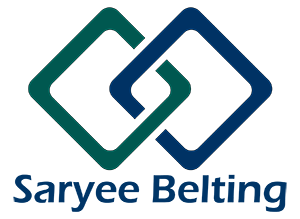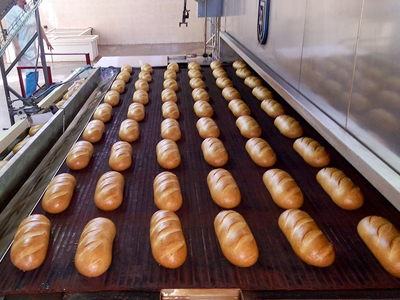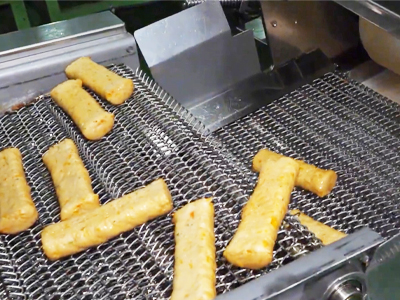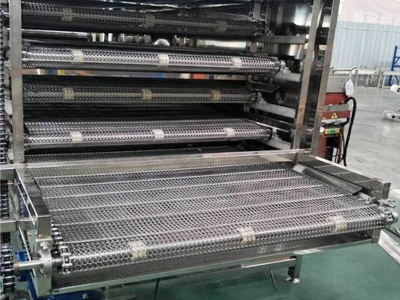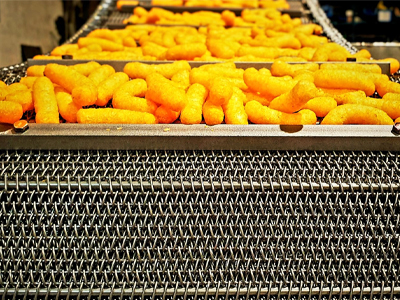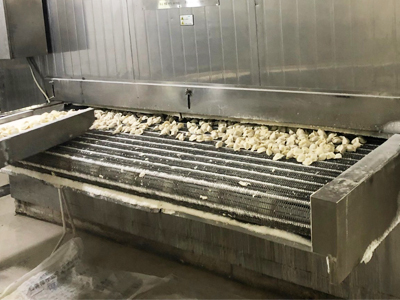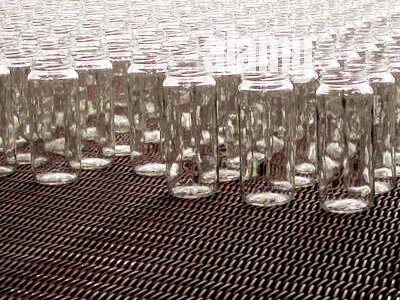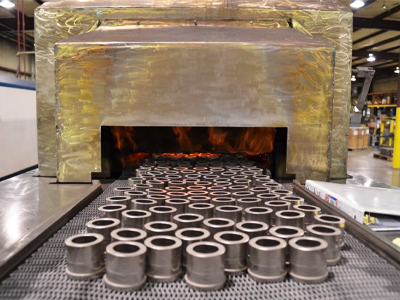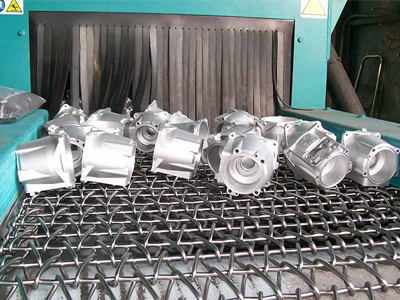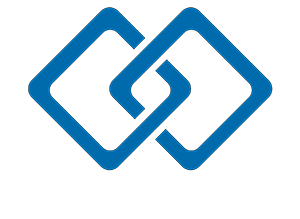Balanced Spiral Woven Conveyor Belts
HOME / PRODUCTS / Metal Conveyor Belts / Balanced Weave Conveyor Belts
Balanced Weave Conveyor Belts for Food Processing or Industrial Applications
The Balanced Spiral conveyor belt from Saryee Belting stands out as a widely favored mesh design, making its mark across diverse manufacturing sectors due to its versatility and broad applicability.
This type conveyor belt offers many advantages, featuring seamless straight-running operation, an impressive strength-to-weight ratio, a wide range of operating temperatures, and an extensive array of mesh specifications tailored to each application’s unique requirements.
Specification
| Material | Stainless, carbon, and galvanized steels, high temperature alloys |
| Coil wire diameter | Round wire: 1.2 mm, 1.4 mm, 1.5 mm, 1.6 mm, 1.8 mm, 2 mm, 2.5 mm, 3 mm Flat wire: from 1.0 mm × 0.7 mm to 6.0 mm × 3.0 mm |
| Cross Wire diameter | 0.8 mm to 8.0 mm |
| Cross wire pitch | 5 mm to 50.8 mm |
| Coil wire pitch | 2.8mm to 40mm |
| Belt width | 100 mm to 5,000 mm |
| Operating temperature | Carbon steel: 538°C Stainless steel: 1120°C Inconel® 601: 1200°C |
Belt Types
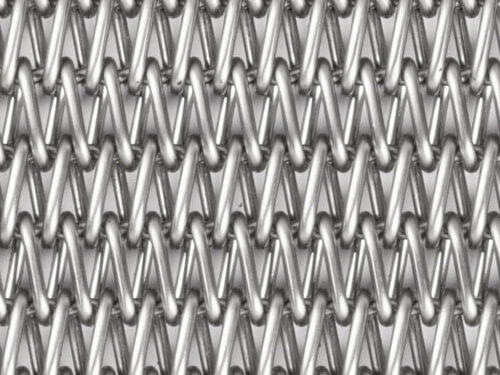

Standard Balanced Weave Belts
Standard Balanced Weave Belts are a specialized type of conveyor belt consisting of a series of left and right-hand wire mesh spirals. These spirals are interconnected by connecting rods or crimped rods.
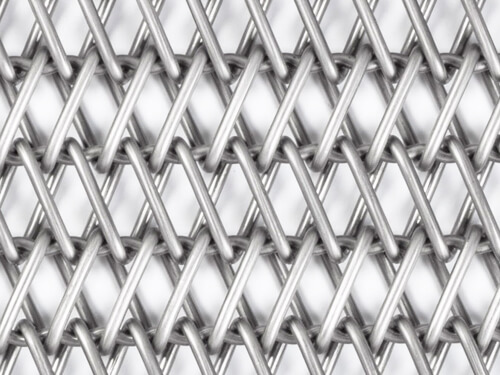

Double Balanced Weave Belts
Double Balanced Weave belts are characterized by a series of left and right-hand wire mesh spirals, with two interwoven left-hand spirals and two interwoven right-hand spirals.
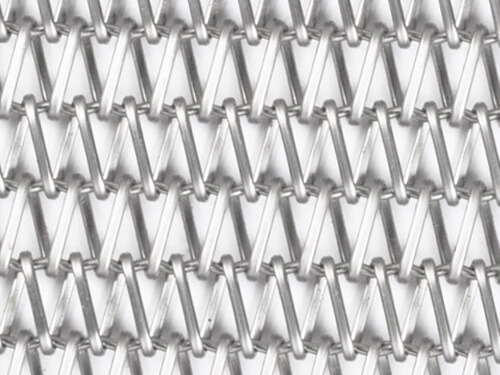

Balanced Weave Belt with Flattened Wire
This conveyor belt features a balanced spiral design with flattened wire, creating a smoother and flatter surface. The flattened wire minimizes initial stretching, providing stability for conveying materials with irregular shapes.
Edge Availability
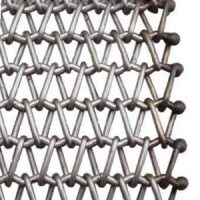

Balanced Weave Belt with Welded Edge
The most common and cost-effective edge finish. Welding both the coil and crimp wires eliminates cut wire ends.
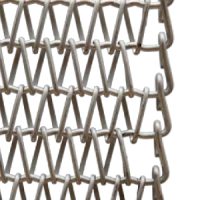

Balanced Weave Belt with Laddered Edge
Less common than the welded edge, suitable where welds are not preferred or welding facilities are unavailable. Provides a smooth belt edge with increased flexibility. Particularly efficient in high-temperature applications, as the laddered edge is not under operational strain, reducing the risk of fracture. Generally available for meshes with a relatively large crimp wire pitch.
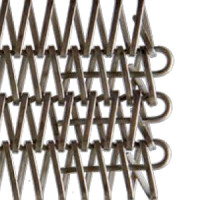

Balanced Weave Belt with Hook Edge
Less common than the welded edge, suitable where welds are not preferred or welding facilities are unavailable. Provides a smooth belt edge with increased flexibility. Generally available for meshes with a relatively large crimp wire pitch.
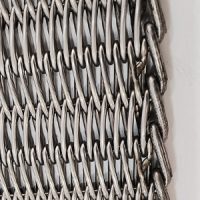

Balanced Weave Belt with Knuckled & Welded
The spirals in this belt are strengthened through the incorporation of straight or "U" cross-rod connectors inserted through their vertices. This construction results in exceptional tensile strength, minimal thermal retention, full loading capacities, and negligible stretch, even at extremely high operating temperatures. Often used in heat treatment and annealing industries.
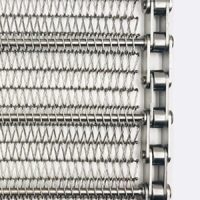

Balanced Weave Belt with Chain Link Edge
In addition to the mentioned mesh edge finishes, these meshes can be driven by side chains using cross rods. Cross rods are located through the mesh coils and then through chains at the edges of the mesh. Chain Edge Balanced Weave Conveyor Belts excel in a wide range of conveying applications, leveraging the advantages of positive drive to enhance operational efficiency. The unique design of these belts simplifies conveyor belt tracking and alignment, streamlining the overall operation.
Methods of Drive
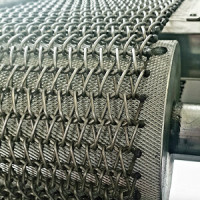

Friction Driven Balanced Weave Belt
The predominant form of drive in conveyor systems is the plain steel parallel roller system. This system relies on the frictional contact between the belt and roller to facilitate belt drive. Variations of this drive type involve the application of lagging materials to the roller, such as rubber or friction brake lining. Incorporating these friction lagging materials enables a reduction in the operational drive tension within the belt, thereby extending the useful life of the belt.
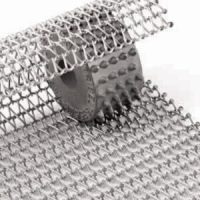

Positive Drive Balanced Weave Belt
Positive Mesh Drive with Specially Manufactured Sprockets. Utilizing specially manufactured sprockets designed to engage with the mesh of the belt ensures a positive drive with minimal belt tension, reducing the risk of belt "Track Off." This innovative approach enhances the reliability and stability of the conveyor system. It's important to note that this range of belts is exclusively offered in the standard "Balanced Spiral" format.
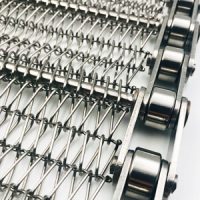

Chain Edge Drive Balanced Weave Belt
Chain edge drive balanced weave belt is also called chain driven conveyor belt. In this configuration of the belt assembly, the cross pitch of the belt mesh is precisely manufactured to ensure that the chain edge serves as the driving medium. The design allows the belt mesh to be pulled through the circuit by the chains, creating a reliable and efficient conveyor system. This approach optimizes the functionality of the chain edge, emphasizing its role in propelling the belt mesh through the operational circuit.
Common Specifications of Balanced Weave Conveyor Belt
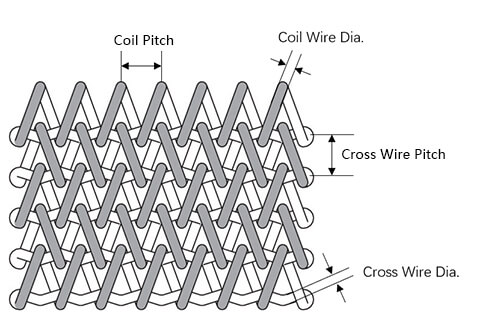

| Specification Coding | Coil Pitch (mm) | Cross Wire Pitch (mm) | Coil Wire Dia. (mm) | Cross Wire Dia (mm) |
| 40-50-6.0-5.0 | 40.0 | 50.0 | 6.0 | 5.0 |
| 25-30-5.0-5.0 | 25.0 | 30.0 | 5.0 | 5.0 |
| 30-40-5.0-4.0 | 30.0 | 40.0 | 5.0 | 4.0 |
| 20-25-5.0-4.0 | 20.0 | 25.0 | 5.0 | 4.0 |
| 15-20-4.0-4.0 | 15.0 | 20.0 | 4.0 | 4.0 |
| 20-25-4.0-3.4 | 20.0 | 25.0 | 4.0 | 3.4 |
| 25-30-4.0-3.2 | 25.0 | 30.0 | 4.0 | 3.2 |
| 15-20-3.4-3.2 | 15.0 | 20.0 | 3.4 | 3.2 |
| 20-25-3.4-3.0 | 20.0 | 25.0 | 3.4 | 3.0 |
| 15-20-3.2-3.0 | 15.0 | 20.0 | 3.2 | 3.0 |
| 10-15-2.6-2.6 | 10.0 | 15.0 | 2.6 | 2.6 |
| 15-20-2.6-2.3 | 15.0 | 20.0 | 2.6 | 2.3 |
| 10-15-2.6-2.3 | 10.0 | 15.0 | 2.6 | 2.3 |
| 8-12-2.3-2.3 | 8.0 | 12.0 | 2.3 | 2.3 |
| 12-18-2.3-2.0 | 12.0 | 18.0 | 2.3 | 2.0 |
| 8-12-2.3-2.0 | 8.0 | 12.0 | 2.3 | 2.0 |
| 6-9-2.0-2.0 | 6.0 | 9.0 | 2.0 | 2.0 |
| 10-15-2.0-1.8 | 10.0 | 15.0 | 2.0 | 1.8 |
| 6-9-1.8-1.8 | 6.0 | 9.0 | 1.8 | 1.8 |
| 10-15-1.8-1.6 | 10.0 | 15.0 | 1.8 | 1.6 |
| 7-10-1.8-1.6 | 7.0 | 10.0 | 1.8 | 1.6 |
| 5-7-1.6-1.6 | 5.0 | 7.0 | 1.6 | 1.6 |
| 8-12-1.6-1.4 | 8.0 | 12.0 | 1.6 | 1.4 |
| 5- 7-1.4-1.4 | 5.0 | 7.0 | 1.4 | 1.4 |
| 9-13-1.6-1.2 | 9.0 | 13.0 | 1.6 | 1.2 |
| 6- 9-1.4-1.2 | 6.0 | 9.0 | 1.4 | 1.2 |
| 4- 6-1.2-1.2 | 4.0 | 6.0 | 1.2 | 1.2 |
| 6- 9-1.2-1.0 | 6.0 | 9.0 | 1.2 | 1.0 |
| 4- 6-1.2-1.0 | 4.0 | 6.0 | 1.2 | 1.0 |
| 3- 4-1.0-1.0 | 3.0 | 4.0 | 1.0 | 1.0 |
| 4- 6-1.0-0.9 | 4.0 | 6.0 | 1.0 | 0.9 |
| 3- 4-1.0-0.9 | 3.0 | 4.0 | 1.0 | 0.9 |
| 4- 5-1.0-0.8 | 4.0 | 5.0 | 1.0 | 0.8 |
| 3- 4-0.9-0.8 | 3.0 | 4.0 | 0.9 | 0.8 |
| NOTE: 1. If flat wire, please give us cross section. 2. Custom specification is available if you can’t find the suitable size. | ||||
Material Availability
| Material | Maximum Operating Temperature °C |
| Carbon Steel | 550 |
| Galvanised Mild Steel | 400 |
| Chrome Molybdenum | 700 |
| 304 Stainless Steel | 750 |
| 316 Stainless Steel | 800 |
| 316L Stainless Steel | 800 |
| 310 Stainless Steel | 1100 |
| 314 Stainless Steel | 1150 |
| 35/19 Nickel Chrome | 1150 |
| 80/20 Nickel Chrome | 1150 |
| Inconel 600 | 1150 |
| Inconel 601 | 1200 |
| If you have other material requirements, please contact us. | |
- Material Selection:
These belts can be manufactured using different materials, such as stainless steel, carbon steel, and other alloys. The material selection depends on the specific requirements of the application, including factors like temperature, corrosion resistance, and load capacity.
- Open Mesh Design:
The open mesh design of balanced weave belts allows for efficient air circulation and drainage. This feature is particularly beneficial in applications where cooling or drainage is essential, such as in the food processing industry.
- High Tensile Strength
Balanced weave conveyor belts are known for their high tensile strength, which makes them suitable for heavy-duty applications. They can handle the transportation of heavy loads and resist wear and tear effectively.
- Easy Cleaning
The open structure of the belts facilitates easy cleaning and maintenance. This is especially important in industries like food processing, where hygiene is a critical factor.
- Temperature Resistance
Balanced weave conveyor belts are capable of withstanding a wide range of temperatures. This makes them suitable for applications that involve extreme heat or cold, such as in ovens or freezers.
- Customization
Manufacturers can customize balanced weave belts to meet specific application requirements, including belt width, length, and edge finishing.
- Long Service Life
Due to their durable construction and high-quality materials, balanced weave conveyor belts have a long service life, contributing to cost-effectiveness over time.
- Positive Drive
Some balanced weave belts feature a positive drive, which means they have sprockets and are positively driven by these sprockets. This can be advantageous in applications where precise product positioning is crucial.
Balanced weave conveyor belts are a type of conveyor belt commonly used in various industries, including food processing, heat treating, baking, annealing, packaging, and industrial processes. These belts are known for their durability, versatility, and efficient conveying capabilities. Here is a detailed breakdown of their applications:
- Conveying and Cooking
- Freezing and Cooling
- Packaging
- Heat Treatment and Annealing
- Industrial Ovens and Furnaces
- Swarf Filter Belts
- Automotive Industry
- Electronics Manufacturing
- Glass and Ceramics Production
- Metalworking
- Aerospace Industry
- Cryogenic Freezers Belts
- Textile Industry
- Chemical Processing
- Pharmaceutical Industry
- General Manufacturing and Assembly
- Lehr Belts for Glass Annealing
- Furnace Mesh Belt
